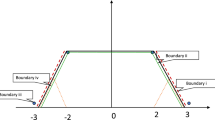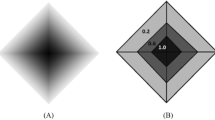Abstract
Many geographical applications need to model spatial phenomena with vague or indeterminate boundaries and interiors. A popular paradigm adopted by the GIS community for this task at the modeling level is fuzzy set theory. A spatial object is fuzzy if locations exist that cannot be assigned completely to the object or to its complement. In previous work, we have proposed an abstract data model of fuzzy spatial data types for fuzzy points, fuzzy lines, and fuzzy regions to represent the indeterminacy of spatial data. This paper focuses on the problem of finding an appropriate implementation approach to fuzzy regions. The idea is to approximate a fuzzy region by a so-called plateau region consisting of a finite number of crisp regions that are all adjacent or disjoint to each other and associated with different membership values determining the degree of belonging to the fuzzy region. Geometric union, geometric intersection, and geometric difference on fuzzy regions are expressed by corresponding operations on the underlying crisp regions. We leverage that several implementations are already available for crisp regions.
Access this chapter
Tax calculation will be finalised at checkout
Purchases are for personal use only
Preview
Unable to display preview. Download preview PDF.
Similar content being viewed by others
References
Altman, D.: Fuzzy Set Theoretic Approaches for Handling Imprecision in Spatial Analysis. Int. Journal of Geographical Information Systems 8(3), 271–289 (1994)
Burrough, P.A., Frank, A.U. (eds.): Geographic Objects with Indeterminate Boundaries. GISDATA Series, vol. 2. Taylor & Francis, Abington (1996)
Clementini, E., Felice, P.: A Spatial Model for Complex Objects with a Broad Boundary Supporting Queries on Uncertain Data. Data & Knowledge Engineering 37, 285–305 (2001)
Cohn, A.G., Gotts, N.M.: The ‘Egg-Yolk’ Representation of Regions with Indeterminate Boundaries. In: Burrough and Frank [2] (1996)
Dilo, A., By, R., Stein, A.: A System of Types and Operators for Handling Vague Spatial Objects. Int. Journal of Geographical Information Science 21(4), 397–426 (2007)
Pauly, A., Schneider, M.: VASA: An Algebra for Vague Spatial Data in Databases. Information Systems 35(1), 111–138 (2010)
Schneider, M.: Spatial Data Types for Database Systems. LNCS, vol. 1288. Springer, Heidelberg (1997)
Schneider, M.: Uncertainty Management for Spatial Data in Databases: Fuzzy Spatial Data Types. In: Güting, R.H., Papadias, D., Lochovsky, F.H. (eds.) SSD 1999. LNCS, vol. 1651, pp. 330–351. Springer, Heidelberg (1999)
Schneider, M., Behr, T.: Topological Relationships between Complex Spatial Objects. ACM Trans. on Database Systems 31(1), 39–81 (2006)
Zadeh, L.A.: Fuzzy Sets. Information and Control 8, 338–353 (1965)
Author information
Authors and Affiliations
Editor information
Editors and Affiliations
Rights and permissions
Copyright information
© 2010 Springer-Verlag Berlin Heidelberg
About this paper
Cite this paper
Kanjilal, V., Liu, H., Schneider, M. (2010). Plateau Regions: An Implementation Concept for Fuzzy Regions in Spatial Databases and GIS. In: Hüllermeier, E., Kruse, R., Hoffmann, F. (eds) Computational Intelligence for Knowledge-Based Systems Design. IPMU 2010. Lecture Notes in Computer Science(), vol 6178. Springer, Berlin, Heidelberg. https://doi.org/10.1007/978-3-642-14049-5_64
Download citation
DOI: https://doi.org/10.1007/978-3-642-14049-5_64
Publisher Name: Springer, Berlin, Heidelberg
Print ISBN: 978-3-642-14048-8
Online ISBN: 978-3-642-14049-5
eBook Packages: Computer ScienceComputer Science (R0)




